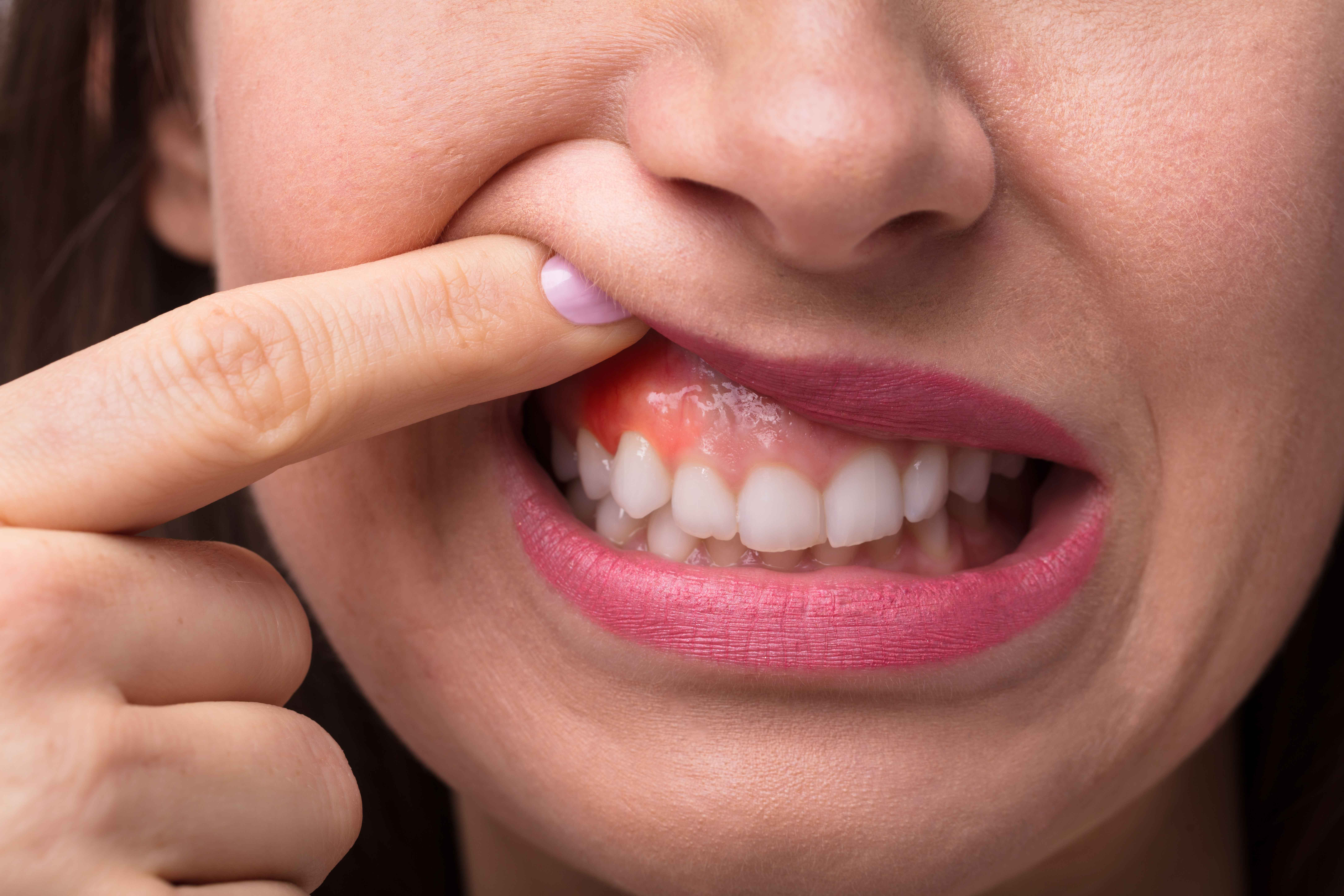Gum Pain: Causes, Symptoms, and Treatments

Summary
In this article, we discuss potential causes of gum pain, the symptoms that can accompany it, and treatments to help relieve your pain.
Key Takeaways
- Takeaway #1: Gum pain can be caused by a variety of factors, including poor oral hygiene, gum disease, vitamin deficiency, hormonal changes, and abscessed teeth.
- Takeaway #2: Gum pain is often accompanied by other symptoms, including tenderness, swelling, bright red or dark red gums, bleeding, bad breath, pain when chewing, and/or loose teeth.
- Takeaway #3: To get rid of gum pain, you’ll need to treat the underlying cause by practicing good oral hygiene (effective brushing, flossing, and using mouthwash) and seeing a dentist. However, you can relieve gum pain temporarily by rinsing with salt water, applying a cold compress, and taking over-the-counter medication.
Table of Contents

This blog has been reviewed and approved by Dr Robert Lee, a dental professional of 35 years
LEARN MORE >Key Takeaways
Causes of Gum Pain
Poor Oral Hygiene
The most common cause of gum pain is poor oral hygiene. Not brushing effectively and flossing enough can cause plaque to build up on your gumline, erode the enamel on your teeth, and eventually lead to infection.
Gum Disease
Gum disease often manifests in stages, starting with gingivitis and progressing to the more serious periodontitis.
Gingivitis — the early stage of gum disease — is characterized by red, swollen, and bleeding gums. The good news is it can be reversed with proper oral hygiene.
Periodontitis — the later, more severe stage — is characterized by your gums pulling away from your teeth, bone loss, and loose teeth. Unlike gingivitis, periodontitis is not reversible.
Vitamin Deficiency
Lack of vitamin B and vitamin C in your diet can lead to swollen and sore gums — alongside other issues, such as exhaustion, headaches, depression, and memory problems (just to name a few).
These deficiencies are more prevalent if you’re not following a healthy, balanced diet that meets the recommended guidelines of enough fruits, vegetables, and lean protein.
Hormonal Changes
Hormone changes can cause gum pain as well. While this condition can affect both men and women, women are more susceptible because of the hormone changes they experience during puberty, menstruation, pregnancy, and menopause.
Pregnancy gingivitis can affect some pregnant women as a result of increased blood flow and hormonal shifts.
Abscessed Tooth
Sometimes, an infection can form below the gumline next to the root of a tooth. This is known as a dental abscess. Abscesses often manifest as swollen, painful gums because the infection is inflamed and is putting pressure on the surrounding tissue.
If left untreated, abscesses can lead to serious complications like systemic infections, so visit your dentist right away if you notice a swollen spot on your gums. They’ll be able to diagnose the problem and recommend an effective treatment.
Symptoms that Can Accompany Gum Pain

Before we discuss other symptoms that might accompany gum pain, keep in mind that these can be signs of underlying conditions. If you experience severe gum pain, gum pain that lasts more than a week, have a fever, or have other concerning symptoms, visit a dentist immediately.
Tenderness and Swelling
As we briefly touched on above, tenderness and swelling are common signs that often accompany gum pain. These symptoms are typically caused by an infection below the gumline that puts pressure on the surrounding tissue.
That same tenderness and swelling may also be a reaction to a piece of food caught at the gumline (popcorn hulls are common culprits).
Bright or Dark Red Gums
When an infection develops, your body may react by pushing blood to the area in an attempt to heal it. This can cause your gums to turn bright or dark red.
If you notice something like this — especially in conjunction with other symptoms on this list — see your dentist right away.
Bleeding
Your gums may bleed from time to time, typically after flossing or eating crunchy foods that rub your gums the wrong way. However, if you notice your gums bleeding for no reason, make an appointment to visit your dentist to identify the problem.
Pain When Chewing
When you chew, the food in your mouth puts pressure on your teeth and gums. If there’s a problem below the gumline, this pressure is going to make any gum pain you may be experiencing even worse.
This is another great reason to visit your dentist, so the underlying cause of the pain doesn’t spread to other teeth or the bones in your jaw.
Loose Teeth
Advanced problems below the gumline can damage the supporting structures of the teeth (the nerves, roots, and bone), resulting in loose, wiggly teeth.
As with the rest of these symptoms, if you notice that your teeth are loose, visit a dentist right away.
Treatments for Gum Pain

See a Dentist
When you’re experiencing dental pain, the best thing you can do is see a dentist. They’ll be able to tell you the best way to remedy the situation.
However, there are some things you can do at home. Let’s take a look.
Improve Oral Hygiene
Take steps to improve your oral hygiene. Typically, that involves:
- Brushing your teeth with a dentist-approved stannous fluoride toothpaste at least twice a day and using an electric toothbrush
- Flossing at least once a day
- Rinsing with a gum detoxifying mouthwash
If you catch gum issues early, effective brushing, flossing, and rinsing can go a long way toward clearing up the issue.
Relieve the Pain
While a dentist can provide excellent treatment and support, you may need to manage your pain at home while waiting for an appointment. Here are some options:
- Rinse with salt water: Add one teaspoon of salt to one cup of warm water. Take a mouthful of the solution and swish it through and around your teeth. Spit out the water. Repeat until the water is gone.
- Apply a cold compress: Soak a washcloth in cold water and hold it against the painful area. Alternatively, you can wrap an ice cube in a washcloth and hold that against the painful area.
- Take an over-the-counter pain reliever: Over-the-counter NSAIDs, like ibuprofen or aspirin, can help reduce inflammation and lessen the pain in your gums. Just remember that they don’t get rid of the underlying problem.
Take Care of Your Gums with Oral-B

When you suffer from gum pain, maintaining a good oral hygiene routine can be difficult, but brushing and flossing may be exactly what you need to feel better again.
Try brushing every day with an electric toothbrush equipped with a sensitive mode, like one from the Oral-B iO Electric Toothbrush Series. With a smart pressure sensor, custom modes, and guided brushing, the iO toothbrushes deliver a gentle yet complete clean every time!
FAQs
-
How can I relieve gum pain?
-
Why do I have gum pain after flossing?
-
Can a gum infection heal itself?
Table of Contents
- Causes of Gum Pain
- Symptoms that Can Accompany Gum Pain
- Treatments for Gum Pain
-
- FAQs
- Sources

This blog has been reviewed and approved by Dr Robert Lee, a dental professional of 35 years
LEARN MORE >
Sign Up
for gum care tips, expert advice, and exclusive offers.

Sign Up
for gum care tips, expert advice, and exclusive offers.


